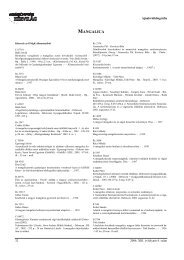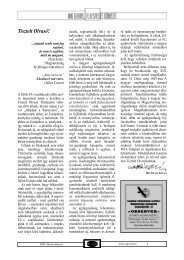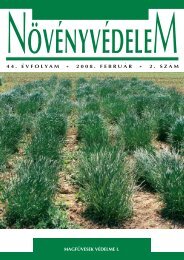hUNGARiAN AGRicUltURAl RESEARch
hUNGARiAN AGRicUltURAl RESEARch
hUNGARiAN AGRicUltURAl RESEARch
You also want an ePaper? Increase the reach of your titles
YUMPU automatically turns print PDFs into web optimized ePapers that Google loves.
Domestication events in the<br />
genus Vitis<br />
The oldest (8,400 B.P.) wild<br />
grape (Vitis sylvestris) seeds<br />
(about 3 mm long) were excavated<br />
in Turkey, at Nevali Çori (NÇ)<br />
located near the Turkish city of<br />
Urfa (37°60’N, 38°70’E, 490 m<br />
above sea level) on the slope of a<br />
Euphrates side valley, Hilvan<br />
province. The first convincing<br />
evidence of Vitis vinifera seeds<br />
with indications of grape cultivation<br />
were also uncovered in<br />
Turkey at Kurban Höyük (5.700–<br />
5.200 B.P. non-calibrated radiocarbon<br />
time), followed by the early<br />
Bronze Age samples (3,200–1900<br />
B.P.) along the Jordan Valley, at<br />
Tell Shuna (Jordan; Chalcoitic),<br />
Jericho (Cisjordan; early Bronze<br />
Age), and Arad (Israel, early<br />
Bronze Age) (Jacquat and<br />
Martinoli 1999). Ancient grape<br />
seeds were also excavated at<br />
Semma (Sudan) 3,500 B.P.<br />
The earliest evidence of wine<br />
production (jars from Godin) was<br />
found in Iran (Hajji Firuz Tepe site<br />
in the Zagros Mountains) about<br />
7,400–7,000 B.P. (This et al.<br />
2006) and 5,500 4,900 B.P. Greek,<br />
Latin, and Egypt vine amphoras<br />
with gelyfied vine remains were<br />
found in the hulls of sunken ships<br />
sunk, similar to the famous<br />
shipwreck remains at Uluburun<br />
near Kas (Turkey). Grape<br />
cultivation gradually spread to<br />
Mesopotamia, Assyria, and Egypt<br />
(about 5,500–5,000 B.P.), and<br />
further west along the<br />
Mediterranean to Phoenicia,<br />
Greece, North Africa and then to<br />
the entire Roman Empire north to<br />
Pannonia (Hungary) and German<br />
tribes. Viticulture also spread<br />
eastward along the Silk Road and<br />
it reached China and Japan in<br />
3,200 B.P.<br />
Grape were introduced to the<br />
Americas by European colonists<br />
starting from the 16 th CENT. after<br />
either the early Chinese explorer<br />
Table 1. Vitis species (1–27), hybrids (1–9) and gene bank samples<br />
(1–12)<br />
Vitis species Vitis hybrids* Vitis gene bank samples<br />
1. Vitis acerifolia 1. V. arizonica x V. rupestris 1. Vitis sp.<br />
2. Vitis aestivalis 2. V. berlandieri x V. riparia 2. Vitis sp. 196-17<br />
3. Vitis amurensis 3. V. berlandieri x V.<br />
3. Vitis sp. 216-N<br />
rupestris<br />
4. Vitis arizonica 4. V. berlandieri x V. vinifera 4. Vitis sp. 44-53M<br />
5. Vitis bashanica 5. V. cinerea x V. riparia 5. Vitis sp. 8007<br />
6. Vitis berlandieri 6. V. cinerea x V. rupestris 6. Vitis sp. 8658<br />
7. Vitis betulifolia 7. V. labrusca x V. vinifera 7. Vitis sp. cv. 'Norton'<br />
8. Vitis bryoniifolia 8. V. pseudoreticulata x V. 8. Vitis sp. CWD 96.701<br />
vinifera<br />
9. Vitis cinerea (downy grape) 9. V. riparia x V. rupestris 9. Vitis sp. Nie 372<br />
10. Vitis davidii 10. Vitis sp. Nie 415<br />
11. Vitis flexuosa * Interspecific hybrids registered in 11. Vitis sp. NL-<br />
Hungary (2006):<br />
12. Vitis heyneana 12. Vitis sp. Qiu<br />
13. Vitis kelungnsis<br />
‘Bianka’; ‘Csillám’;<br />
14. Vitis labrusca(Concord grape) ‘Duna gyöngye’; ‘Esther’;<br />
15. Vitis piasezkii<br />
‘Fanny’; ‘Göcseji zamatos’;<br />
16. Vitis popenoei (totoloche grape) ‘Kunleány’; ‘Medina;<br />
‘Nero’; ‘Odysseus’;<br />
17. Vitis pseudoreticulata<br />
‘Orpheus’; ‘Platina’;<br />
18. Vitis quinquangularis<br />
‘Pannon frankos’; ‘Pölöskei muskotály’;<br />
19. Vitis riparia (riverbank grape) ‘Refrén’; ‘Taurus’;<br />
20. Vitis rotundifolia (fox grape) ‘Teréz’; ‘Viktória gyöngye’;<br />
21. Vitis rupestris (rock grape)<br />
‘Zalagyöngye’.<br />
22. Vitis shuttleworthii (callose<br />
23. Vitis sinocinerea<br />
24. Vitis thunbergii<br />
25. Vitis tiliifolia<br />
26. Vitis vinifera(wine grape)<br />
27. Vitis yeshanensis<br />
Zheng He (1405–1435), or<br />
Columbus voyages (first: Aug. 3<br />
1492 to March 15 1493; second:<br />
Sept. 25 1493 to June 11 1495;<br />
third: May 30 1498 to Nov. 15<br />
1500; fourth: May 11 1502 to Nov.<br />
7 1504). The first plantations in<br />
North America were established<br />
on the West Coast by Spanish<br />
missionaries and later by Hungarian<br />
viticulturists like Ágoston<br />
Haraszty who is considered the<br />
‘father of California’s grapegrowing<br />
industry’. Haraszty<br />
imported 200,000 grape cuttings<br />
from Europe from 1849, including<br />
grape varieties from his native<br />
Hungary. With the passing of time,<br />
Haraszty developed over half a<br />
million California acres to<br />
viticulture, making wine growing<br />
second to orange production in the<br />
state’s agricultural economy. In<br />
recognition of his merits, Haraszty<br />
was named California’s State<br />
Commissioner of Viticulture (Sisa<br />
2006).<br />
European grape formed<br />
hybrids with native Vitis species<br />
growing in North America. Some<br />
of these hybrids became resistant<br />
to Phyloxera (an insect pest),<br />
which devastated European<br />
vineyards in the 1880s, and<br />
supplied resistant rootstocks for<br />
replantations. This event indicates<br />
that the diversity of grape genome<br />
has been narrowed twice; first by<br />
the Biblical<br />
flood, followed by the re<br />
plantation of Noah ‘the first<br />
vintner’ (Genesis 9) on Mount<br />
Ararat, and second by Phyloxera<br />
(This et al. 2002). Unlike the<br />
genome for dioecious V. sylvestris,<br />
genetic diversity of grape has been<br />
narrowing continuously as the<br />
result of vegetative propagation<br />
either by rooting of twigs, or by<br />
grafting.<br />
In Hungary, the earliest wild<br />
grape (Vitis sylvestris) seed<br />
remains were found at Tiszapolgár<br />
(5,300 B.C.) and the earliest Vitis<br />
vinifera at Sopron (1,300 B.C.),<br />
which dates the origins of grape<br />
cultivations to the late Bronze Age<br />
(Table 2, Fig. 1).<br />
Hungarian Agricultural Research 2009/3–4 9
















